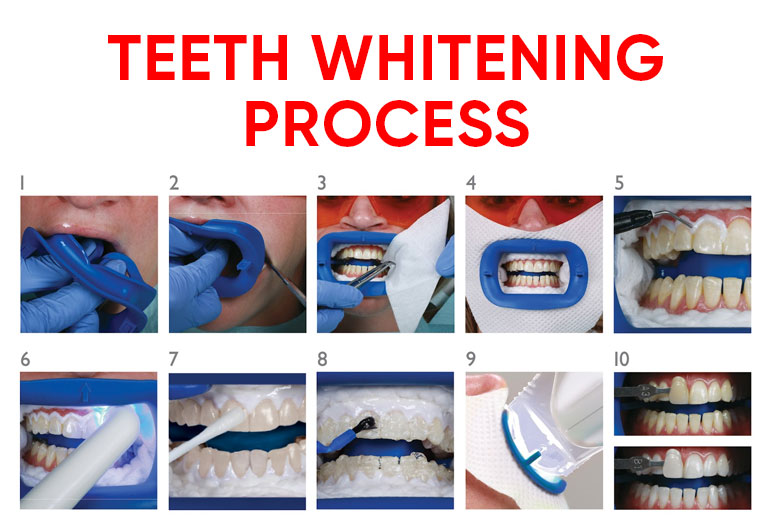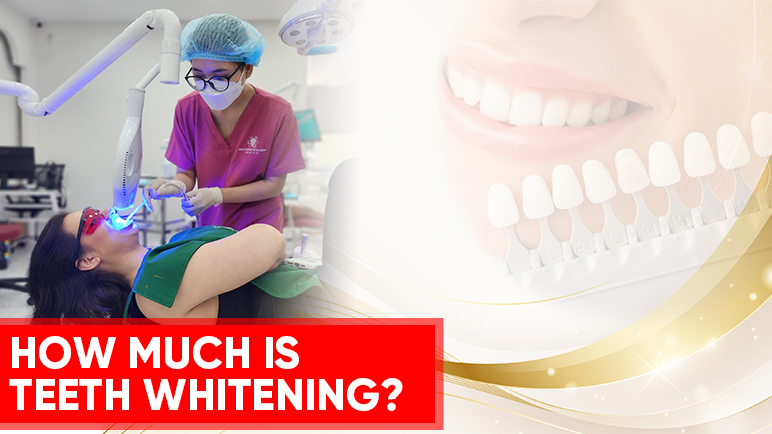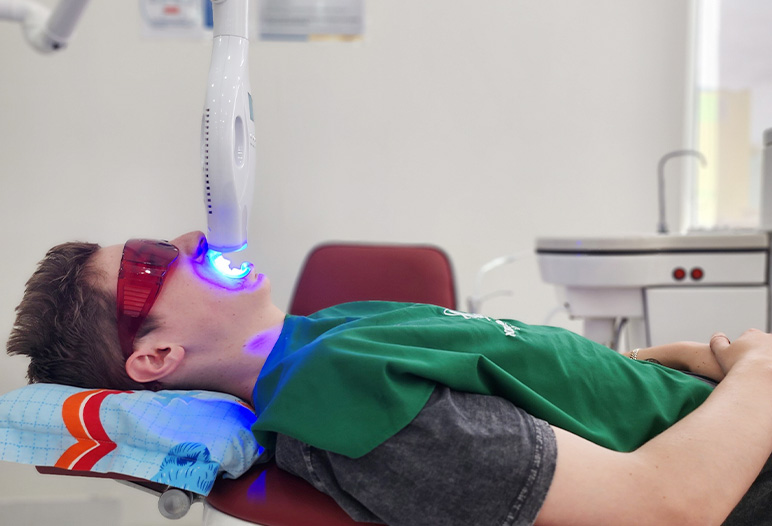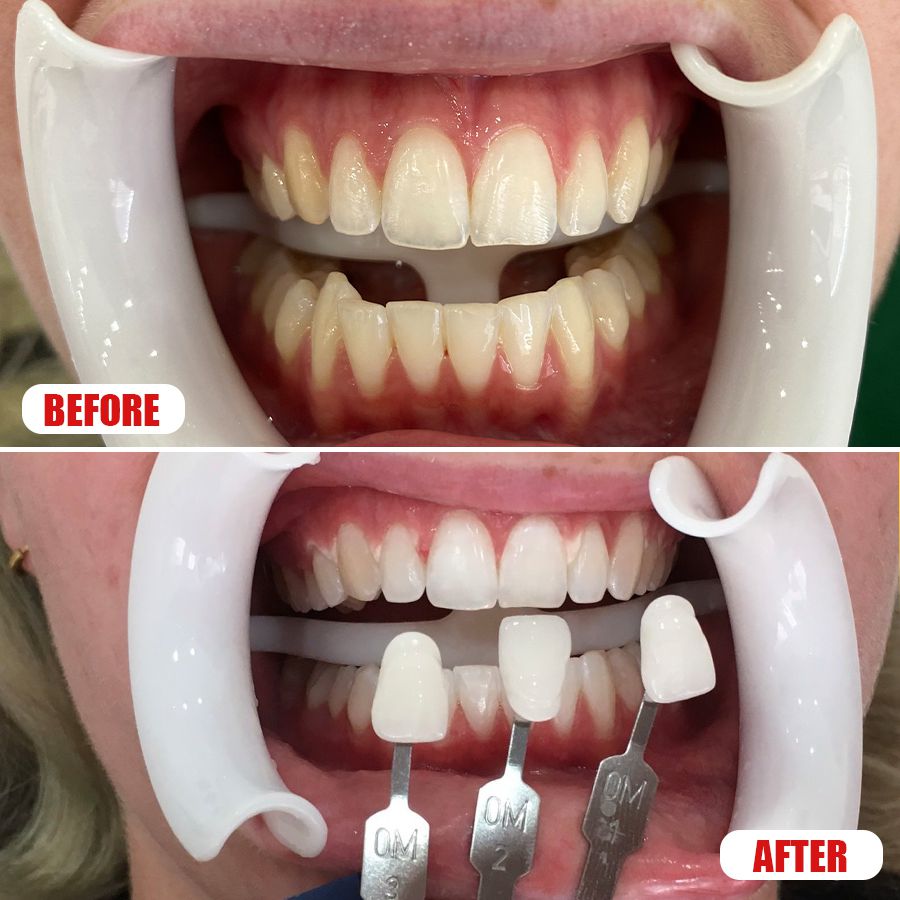The teeth whitening process is a transformative journey that enhances not only your smile but also your confidence. This cosmetic procedure, which has gained immense popularity in recent years, involves techniques that ensure your teeth regain their natural luster. Before embarking on this exciting adventure toward a brighter smile, it’s crucial to delve into the specifics of how teeth whitening is performed. This article will explore various aspects of the teeth whitening process and provide insights into everything from preparation to aftercare.
Teeth whitening process
Understanding the teeth whitening process is essential for anyone considering brightening their smile. It’s more than just applying a chemical solution; it involves a series of steps designed to maximize results while ensuring safety.
The procedure typically begins with a thorough dental examination, where a professional assesses your oral health and identifies any issues that could affect the treatment’s success. This preliminary step is critical to safeguarding your teeth and gums during the whitening process. Once cleared, you can expect a comprehensive cleaning of your mouth to eliminate any debris or bacteria that may interfere with the whitening agent’s effectiveness.
After ensuring a clean slate, the next phase involves protective measures for your lips and gums. Since the chemicals used in whitening agents can be harsh, dentists employ various tools such as lip retractors and gingival barriers. These precautions help minimize discomfort and prevent damage to sensitive areas inside your mouth.
Once you’ve been adequately prepared, the dentist applies the whitening solution directly to your teeth. This part of the teeth whitening process is where the magic truly begins. The use of laser light or specialized equipment accelerates the reaction between the whitening agent and the stain molecules embedded in your teeth. This is followed by a post-treatment cleaning to remove any remnants of the whitening agent. Overall, the entire procedure aims to achieve a dramatic enhancement in the color of your teeth, giving you a brighter and more radiant smile.

Importance of professional supervision
One of the most significant benefits of undergoing the teeth whitening process at a professional clinic is the expertise of trained dentists. They possess the knowledge and skills necessary to evaluate your specific needs and tailor the treatment accordingly. Unlike over-the-counter products that often provide mediocre results, professional whitening offers a customized approach aimed at achieving optimal brightness without compromising safety.
Furthermore, dental professionals are equipped to manage potential side effects, such as tooth sensitivity or gum irritation, which may arise during or after the procedure. Their ability to monitor your progress ensures that any complications are promptly addressed, making your experience far more comfortable.
Popularity and trends in teeth whitening
In recent years, the demand for teeth whitening treatments has skyrocketed, fueled by social media and the growing emphasis on aesthetics. Individuals now recognize the importance of having a dazzling smile, leading to an increase in visits to dental clinics specifically for whitening.
Trends like “smile makeovers” and “selfies” have positioned teeth whitening as a standard part of personal grooming routines. Many people are curious about how to achieve the best results, driving awareness around the teeth whitening process and its myriad options available today.
How to get teeth whitened
If you’re looking to enhance your smile, understanding how to get teeth whitened effectively is crucial. Numerous methods exist, but knowing the nuances can lead to a more satisfactory outcome.
When considering your options, it’s important to weigh the pros and cons of different whitening treatments. In-office treatments conducted by dental professionals tend to deliver faster and more noticeable results. These procedures utilize stronger whitening agents and advanced technology, significantly reducing the time required to achieve your desired shade.
On the other hand, at-home whitening kits offer convenience and flexibility but often take longer to show results. Over-the-counter products like whitening strips can be effective, but they may not always match professional results due to differences in concentration levels and application techniques.
Consultation with a dental professional plays a vital role in determining the best course of action. They will assess your dental health, discuss your goals, and recommend a tailored approach based on your unique circumstances.
At-Home vs. Professional treatments
Choosing between at-home and professional treatments can be challenging. Both methods have their merits, but understanding the key distinctions will help inform your decision.
At-home treatments often come with ease and affordability. You can whiten your teeth in the comfort of your own home at your own pace. However, the results may vary, and some users report dissatisfaction in achieving the desired brightness.
In contrast, professional treatments yield immediate and dramatic improvements. While they might involve a higher cost, the overall satisfaction often outweighs the expense. Professional whitening also provides a safer environment, as dentists monitor the process to avoid mishaps.
Factors to consider in teeth whitening
Before embarking on your teeth whitening journey, several factors must be considered. Key elements include existing dental conditions, the severity of discoloration, and personal habits that may contribute to staining.
Individuals with dental restorations or severe enamel erosion might not be suitable candidates for certain whitening treatments. Consulting with a dentist helps clarify any restrictions and expectations.
Additionally, your lifestyle choices matter immensely. Frequent consumption of dark-colored beverages, smoking, or poor oral hygiene practices can undermine the effectiveness of whitening efforts. A commitment to maintaining oral health and good habits can prolong the results of your teeth whitening experience.
How does professional teeth whitening work
To fully appreciate the benefits of teeth whitening, it’s crucial to understand how does professional teeth whitening work. This knowledge will help demystify the process and prepare you for what to expect.
The foundation of professional teeth whitening lies in the use of oxidizing agents, such as hydrogen peroxide or carbamide peroxide. These compounds are designed to penetrate the enamel and dentin layers of your teeth. Once they reach the stain molecules, oxidation occurs, breaking down the discolored particles and allowing the natural white color of your teeth to shine through.
During a professional session, your dentist carefully selects the appropriate concentration of the whitening agent based on your current tooth color and sensitivity level. This personalized approach sets professional whitening apart from over-the-counter alternatives, which often deliver generic results.
Another essential aspect of professional whitening is the use of light activation. Many clinics incorporate laser or LED lights to enhance the reaction between the whitening agent and the stains on your teeth. The light essentially accelerates the process, resulting in quicker and more effective outcomes.

Safety measures in professional whitening
Safety is paramount in any cosmetic procedure, which is why professional teeth whitening prioritizes patient protection. Dentists utilize various safeguards to minimize risks associated with chemical exposure and tooth sensitivity.
Before commencing treatment, dental professionals perform a comprehensive examination to identify potential issues that could complicate the whitening process. Protective barriers are then applied around the lips and gums to shield delicate tissues from irritation caused by the whitening agents.
Throughout the procedure, the dentist closely monitors your response to the treatment, adjusting the concentration of the whitening agents if necessary. This vigilant oversight ensures that your experience remains comfortable and yields optimal results.
Expected outcomes and timeline
Understanding what to expect post-treatment can alleviate anxiety and heighten excitement for your new smile. Generally, professional teeth whitening results may become evident instantly but will continue to develop over several days as your teeth adjust to the new shade.
Most individuals see a noticeable difference immediately after the procedure. However, it’s essential to recognize that your teeth may appear even brighter after a few days as the final color stabilizes. Depending on the initial shade of your teeth, multiple sessions may be needed to achieve your desired outcome.
The longevity of the results varies based on lifestyle factors, including diet and oral hygiene practices. By committing to regular touch-ups and avoiding stain-causing substances, you can maintain your radiant smile for months or even years.
Getting teeth bleached
The term “getting teeth bleached” often conjures images of gleaming whites and enhanced self-confidence. However, the reality encompasses a bit more than just the final aesthetic.
Bleaching refers specifically to the processes that reduce the intrinsic stains within the tooth structure. Unlike surface-level whitening, bleaching delves deeper into the tooth’s chemistry, requiring a more potent formula or method.
When speaking about getting teeth bleached, it’s essential to differentiate between mean methods. Just as there are various types of whitening treatments, a distinction exists between simple whitening and intensive bleaching.
The primary goal remains the same: to achieve a brighter, whiter smile. However, each method caters to varying degrees of discoloration. For example, intrinsic stains stemming from genetics or trauma may respond better to bleaching rather than superficial whitening techniques.
Bleaching agents used
A variety of bleaching agents are employed in professional settings, each formulated to target specific types of stains. Hydrogen peroxide is one of the most common agents used, praised for its efficacy in penetrating tooth enamel and tackling stubborn discolorations.
Carbamide peroxide is another popular choice, distinguished by its longer-lasting effects. Although slightly less concentrated than hydrogen peroxide, carbamide peroxide breaks down into hydrogen peroxide once applied to the teeth, offering similar benefits over extended periods.
Dentists often utilize custom formulations and concentrations tailored to the individual’s needs, ensuring maximum efficacy while minimizing side effects. The careful selection of bleaching agents plays a pivotal role in achieving successful outcomes while protecting your teeth’s integrity.
The experience of getting teeth bleached
Experiencing the process of getting teeth bleached can be both exciting and nerve-wracking. Many individuals enter the dental clinic with high hopes, eager to leave with a newfound glow.
As the procedure unfolds, you’ll find that a dedicated team of professionals works to ensure your comfort throughout the bleaching session. From protective gear to gentle handling, every detail matters in creating a pleasant atmosphere.
Post-treatment, many patients describe feelings of rejuvenation and relaxation as they catch glimpses of their brighter smiles in the mirror. Each person’s experience varies, but the underlying theme is one of anticipation and satisfaction.
Teeth whitening surgery
While the term “teeth whitening surgery” might sound alarming, it doesn’t refer to invasive procedures but instead highlights the meticulous nature of professional whitening techniques. Understanding this terminology helps demystify the intent behind the phrase.
Teeth whitening surgery incorporates advanced methodologies and equipment, ensuring maximum efficiency and safety. Dental professionals are trained to perform this procedure with precision, so calling it a form of surgery emphasizes the seriousness and professionalism involved.
Patients may perceive the term as intimidating, but it merely signifies a professional undertaking intended to elevate your oral aesthetics safely. Ensuring clarity around this terminology can foster a sense of reassurance as you consider investing in your smile.
Non-invasive nature of teeth whitening surgery
Despite the surgical connotation, teeth whitening surgery is entirely non-invasive. Techniques used during the whitening process do not require any cutting or removal of tissue, making it considerably less daunting than traditional surgical procedures.
The application of the whitening agent and the use of lasers or light sources are all external methods that cause no harm to the integrity of your teeth. Therefore, patients can approach the idea of teeth whitening surgery with a sense of calmness, knowing that they are opting for a safe and effective treatment.
Long-term effects of teeth whitening surgery
One major question revolves around the durability of results following teeth whitening surgery. Many patients wonder how long they can expect their newly brightened smiles to last.
Generally, the effects of professional whitening can endure for months to years, contingent upon ongoing care and lifestyle decisions. Regular dental hygiene practices and periodic touch-ups can significantly prolong the vibrancy attained through the initial whitening session.
Additionally, avoiding foods and drinks that contribute to staining will further enhance the longevity of your results. As with any cosmetic endeavor, commitment to maintenance is key in ensuring the effectiveness of your decision to undergo teeth whitening surgery.

Best way to whiten teeth professionally
Determining the best way to whiten teeth professionally involves a combination of personal preference, desired outcomes, and expert recommendations. With various options available, finding the ideal path can be transformative.
Professional whitening techniques encompass in-office treatments, take-home kits provided by dentists, and combination approaches that include both options. Understanding the pros and cons of each can help you navigate this decision.
In-office treatments offer immediate gratification, showcasing remarkable results within a single visit. The advanced technology employed ensures a comprehensive bleaching experience, addressing deep set stains effectively.
Alternatively, take-home kits allow for gradual improvement, granting you control over the whitening process. Though they may take longer to reveal results, this option permits greater flexibility and can often be done alongside regular routines.
Considering personal goals
Establishing your personal goals is instrumental in determining the best way to whiten teeth professionally. Are you seeking a quick boost before a special event, or are you looking for a long-term solution?
Taking time to evaluate your needs will guide your decision-making process. If instant gratification is a priority, in-office treatments may align better with your aspirations. Conversely, if you’re willing to invest time for gradual improvement, take-home kits might be more appealing.
Consultation with professionals
Engaging with dental professionals provides invaluable insight into how to achieve your whitening goals effectively. During consultations, dentists assess your dental health and present tailored solutions designed to suit your unique requirements.
By actively participating in discussions about your preferences, expectancies, and concerns, you can collaboratively develop a plan that aligns with your aspirations. This partnership fosters a sense of confidence and assurance as you embark on this transformative journey.
Teeth bleaching procedure
Delving into the teeth bleaching procedure illuminates the details necessary for achieving a beautiful smile. While many associate teeth whitening strictly with surface stains, bleaching delves deeper into intrinsic discoloration.
Bleaching differs fundamentally from standard whitening techniques primarily due to its focus on internal stains. The teeth bleaching procedure uses concentrated agents designed to penetrate deeper layers of the enamel, targeting persistent discolorations that may not respond to traditional methods.
Understanding the steps involved in this procedure can help dispel apprehensions and create enthusiasm for the potential outcomes. Each phase of the bleaching process is carefully orchestrated to ensure safety and efficacy.
Detailed steps of the bleaching procedure
The teeth bleaching procedure commences with a thorough dental examination. This allows the dentist to evaluate the condition of your teeth and decide whether bleaching is the right choice for you.
Following the assessment, the dentist will conduct a professional cleaning, removing any plaque or debris that could hinder the bleaching agent’s performance. Once prepared, the dentist applies the bleaching agent, often accompanied by the use of specialized light sources to enhance results.
After a predetermined duration, the bleaching agent is removed, and the dentist completes any necessary follow-up care instructions. Patients often leave the office with a sense of accomplishment and eagerness to showcase their newly brightened smiles.
Managing expectations
It’s essential to have realistic expectations regarding the teeth bleaching procedure. While significant improvement is often achievable, complete color restoration may not be feasible for everyone.
Factors such as the severity of stains, existing dental conditions, and individual response to the bleaching agents all contribute to the overall outcome. Open communication with your dentist can help temper expectations and foster a positive attitude towards the results.
Teeth whitening procedure
Familiarizing yourself with the teeth whitening procedure will empower you to make informed decisions regarding your dental care. This process goes beyond mere aesthetics, aligning closely with dental health.
The initial stage of the teeth whitening procedure involves consultation with your dentist to discuss your goals and determine the most appropriate approach. A comprehensive dental exam usually accompanies this discussion, laying the groundwork for your personalized treatment plan.
Once you’re deemed an appropriate candidate for whitening, the actual procedure commences. After performing a thorough cleaning, your dentist will apply protective barriers and the whitening agent to your teeth.

What happens during the whitening procedure
During the teeth whitening procedure, your dentist carefully monitors the application of the whitening agent to ensure maximum exposure and effectiveness while minimizing discomfort.
Typically, the light activation phase follows, where specialized equipment directs light onto your teeth to amplify the agent’s efficacy. The waiting period varies, with most sessions lasting anywhere from 30 to 90 minutes, depending on the chosen technique and your specific goals.
Afterward, the dentist performs a final cleaning, removing all residual whitening agents and providing you with post-treatment care instructions. Many patients walk away feeling elated, already dreaming of flashing their new smiles.
Post-procedure care and maintenance
Post-whitening care is vital to ensuring the longevity of your results. Following the teeth whitening procedure, it’s advisable to avoid highly pigmented foods and drinks for a few days to prevent any potential re-staining.
Maintaining excellent oral hygiene practices will further enhance your whitening results. Brushing and flossing regularly, along with routine dental check-ups, can help keep your smile radiant for an extended period.
Conclusion
Embarking on the journey of teeth whitening is an exciting endeavor that promises to elevate not just your smile but your overall confidence. Understanding the intricacies of the teeth whitening process equips you with the knowledge to make informed decisions and choose the right path toward achieving a brighter, more vibrant smile.
From exploring various methods and understanding how they work to considering professional advice, every aspect plays a role in guiding you toward your goals. Always remember that when it comes to your dental health, consulting experienced professionals is crucial for long-lasting results and peace of mind.
With a little research and the right support, you can unlock the full potential of your smile and embrace the beauty of confidence that comes with it!



Block "about-saigon-center-dental-clinic" not found